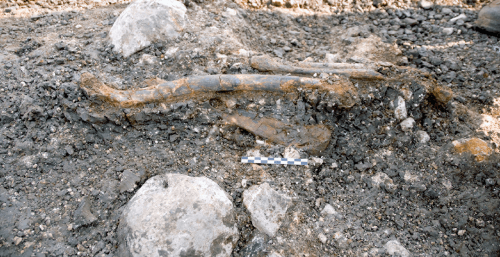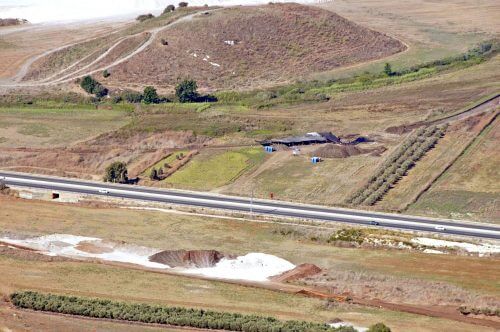A new study refutes the notion that Neanderthals only lived in caves

The Neanderthal man, who was nicknamed the "cave man", lived, in fact, also in the field, more durable than what was commonly thought. So claims a study by a team of researchers from Israeli and international research institutions, published today in the prestigious journal Scientific Reports. According to the study, the Neanderthal groups in the Levant constituted a resistant population, and successfully existed in the north of the country about 60,000 years ago, when modern human groups arrived in the area from Africa. The research refutes the hypotheses according to which the Neanderthals disappeared from the area and left it to modern man due to their being a weak population, unable to cope with the climatic conditions. The assertion that this is a successful population in terms of dealing with the environment further strengthens the question mark surrounding the reason for the disappearance of the Neanderthals from our region.
The research, under the direction of Dr. Ella Bin from the Ono Academic College, Prof. Arala Hobars from the Institute of Archeology at the Hebrew University of Jerusalem and Dr. Omri Barzilai from the Antiquities Authority, with the assistance of Dr. Ravid Eckstein (Hebrew University) and Dr. Ariel Malinsky-Buler (The Museum of Prehistory in Monrepo, Germany), financed by Derech Eretz as part of the project of the continuation of Highway 6 to the north. The study examined partial remains of two human skeletons that were uncovered at the Ein Kashish site, on the bank of the Kishon River. The examination of the remains revealed that for the first time in the history of research in the Levant, human skeletons from this time period were identified outside the caves. The findings were dated by Dr. Naomi Porat from the Geological Institute of Israel to the Late Middle Paleolithic period, to the time period between 70-60 thousand years.
The remains of the ancient individual between the two is a molar tooth which was studied by Dr. Stefano Benazi and other researchers from the University of Ravenna in Italy and the Max Planck Institute in Leipzig. This tooth was identified as belonging to a Neanderthal man through imaging methods and advanced statistical analyses. Another relic, later than the previous one, were the remains of the lower limbs of a young Neanderthal (15-22 years old), who apparently suffered an injury that caused him to limp. This finding was investigated by Dr. Ella Bin, together with a team of researchers from Bar-Ilan University and Tel Aviv University. In the same layer were discovered flint and stone tools, bones of animals that were used as a source of meat, and special finds such as a sea shell, blocks of dyes and an antler of the Carmel deer.

The fate of the Neanderthals and the nature of their communication with modern man are one of the central questions in the study of the Middle Paleolithic period, which lasted about 200,000 years. The Middle East is the only region known today where both populations existed during this period. Following the discovery of an elderly man, it is possible, for the first time in the history of research in our region, to associate material culture remains with the Neanderthals, who until now were only known in caves. The research shows that the Neanderthals returned to the Ein Kasish site several times, and that the settlement system of the Neanderthal groups included both caves and open sites.
Researchers and students from the Antiquities Authority, the Hebrew University, Tel Aviv University and Haifa University participated in the excavation and research.
"Recently, a number of researchers have suggested that Neanderthals adapted to life in mountainous areas, while modern man adapted to life in open areas." say the researchers. "The find of an elderly man indicates that the Neanderthals inhabited sites in varied topographical and ecological conditions."

If, As the research indicates, a lack of ecological adaptation does not explain the disappearance of the Neanderthals from the region, the question arises - What could explain this??
Another question that is found in research discussion is the reason for the disappearance of the Neanderthals. One of the explanations put forward was that the Neanderthal groups in the region had difficulty coping with the results of the gradual climatic drying that characterized this time period. The unique find of an elderly man disproves the hypothesis that the Neanderthals disappeared from the area due to climatic conditions. The find also indicates that the Neanderthal groups had a pattern of returning to sites in the open landscape, and re-settled them during the period. The findings indicate that the Neanderthal groups in the region were a resistant population that successfully existed in the north of the country at the time of the appearance of modern human groups in our region that arrived from Africa about 60,000 years ago."
Explanations on this subject are varied: some speculate that modern man, who arrived in the region from Africa about 60,000 years ago, was a carrier of tropical diseases that damaged the resilience of the Neanderthals. Another suggestion is that the two populations had a similar level of fitness and that the disappearance of the Neanderthals was accidental. Other researchers speculate that the modern man killed the Neanderthals until they disappeared, on the basis of the "strong survives", and another opinion is that the mating between the modern man and the Neanderthals eventually led to the disappearance of the Neanderthal population.
See more on the subject on the science website:

7 תגובות
Michael, Gamani I really liked the series; I mostly remember the first book. The second and the third less so, although at the time I actually preferred the theories of "communication between the sexes" which are much more common there. getting old…
My father, you have a serious faith problem. Instead of looking at reality and trying to understand why the creator of the world chose to do what he did/is doing in this way. You come and screw up all his hard work with distortions and distortions of reality that I'm sure cause him to lose at least half an hour of sleep once a thousand years.
Give him the respect, after he labored and worked to scatter bones, teeth and armor with masterly precision according to dates, location and geological layers - refer to the findings themselves. Don't drool over some pseudoscientific movie you saw on Kodi and decided it proved that all the other articles are bullshit.
I saw a movie yesterday on the National Geographic website,
The film was very elaborate, full of beautiful effects and animation, and lasted over an hour.
The film dealt with the evolution of dinosaurs into birds.
except that no evidence or scientific findings were presented there, everything was presented in the form of facts,
The only find that was presented was one fossil of a dwarf dinosaur with feathers that was found in China - and I noticed that the whole beautiful and invested two-hour theory about a small flying dinosaur was based only on this find and they also tried to explain in a scientific way why, unlike birds that exist today, that dinosaur does not have a prominent breast bone that supports muscles Aviation as expected was a creature that flies.
And I remember that a few years ago it was announced that this find that was found in China at all was a fake find.
So that's the level of credibility of the popular science films you see on National Geographic and the science channels.
In another movie I saw in the promo - a movie where Leonardo DiCaprio was hired to fly to the poles to shoot a movie about global warming, I don't think I'll bother to see. It is clear that this is a propaganda film.
my father
You have an amazing talent for babbling nonsense.
It should be clear to everyone that in hot/hot areas and in dry seasons the Neanderthals did not need caves. (They had fire against predators). just what? It is easy for researchers to search under the flashlight - that is, in caves. I assume that in the future more of their camps will be discovered. But the statistical chance is very low - such discoveries are only possible by chance as happened here. This means that researchers are still better off looking for caves and exploring them.
But what bothers me about the whole thing is the German name that breaks my teeth. Couldn't they just be called Germans? 🙂
Nev, - I once read that there are researchers who proved the existence of genes from several groups of early humans in people of our time so that in their opinion the Neanderthals did not become extinct but mixed with Homo sapiens and the others.
I heard a theory that after the creation of man by God, some became Neanderthals and some became Homo sapiens... and the rest became monkeys.
This concept is accepted by some religious and creationists.
The theory of this "revolution" fits the logic of Darwin's evolution, and there is no conclusive proof that it was not so.
The scientists' assumption that man is a more developed creature than the other primates is only due to the fact that we see the development of the mind as something more advanced than other features, but this does not have to be the case, theoretically according to Darwin's theory there is no obstacle for man to lose his intelligence, the ability to speak and so on and develop programming of climbing trees. For example, a tribe of humans living in the wild develops a mutation of a creature that is indeed retarded in its intelligence, but with agile qualities and the ability to use the foot like the palm of the hand, the ability to live in a group on trees and the rest of the advantages that a monkey has in nature, and the rest are extinct because they are weak, naked creatures, etc...
Brings me back to the series of fascinating books of the cave bear tribe written by the writer Jean M. Oel - those who like the subject and connect in imagination to what was, are invited to read these fascinating books, about life once upon a time and the communication between the two sexes.